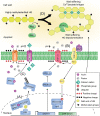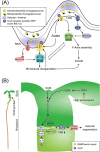Auxin as an architect of the pectin matrix
- PMID: 37166384
- PMCID: PMC10690733
- DOI: 10.1093/jxb/erad174
Auxin as an architect of the pectin matrix
Abstract
Auxin is a versatile plant growth regulator that triggers multiple signalling pathways at different spatial and temporal resolutions. A plant cell is surrounded by the cell wall, a complex and dynamic network of polysaccharides. The cell wall needs to be rigid to provide mechanical support and protection and highly flexible to allow cell growth and shape acquisition. The modification of the pectin components, among other processes, is a mechanism by which auxin activity alters the mechanical properties of the cell wall. Auxin signalling precisely controls the transcriptional output of several genes encoding pectin remodelling enzymes, their local activity, pectin deposition, and modulation in different developmental contexts. This review examines the mechanism of auxin activity in regulating pectin chemistry at organ, cellular, and subcellular levels across diverse plant species. Moreover, we ask questions that remain to be addressed to fully understand the interplay between auxin and pectin in plant growth and development.
Keywords: Auxin; calcium (Ca2+); cell wall; microdomains; pH; pectin; pectin methylesterase.
© The Author(s) 2023. Published by Oxford University Press on behalf of the Society for Experimental Biology.
Conflict of interest statement
The authors have no conflicts of interest to declare.
Figures


Similar articles
-
Rosa hybrida RhERF1 and RhERF4 mediate ethylene- and auxin-regulated petal abscission by influencing pectin degradation.Plant J. 2019 Sep;99(6):1159-1171. doi: 10.1111/tpj.14412. Epub 2019 Jun 26. Plant J. 2019. PMID: 31111587
-
Drought Disrupts Auxin Localization in Abscission Zone and Modifies Cell Wall Structure Leading to Flower Separation in Yellow Lupine.Int J Mol Sci. 2020 Sep 18;21(18):6848. doi: 10.3390/ijms21186848. Int J Mol Sci. 2020. PMID: 32961941 Free PMC article.
-
Initiation of leaf somatic embryogenesis involves high pectin esterification, auxin accumulation and DNA demethylation in Quercus alba.J Plant Physiol. 2017 Jun;213:42-54. doi: 10.1016/j.jplph.2017.02.012. Epub 2017 Mar 1. J Plant Physiol. 2017. PMID: 28315794
-
The Role of Auxin in Cell Wall Expansion.Int J Mol Sci. 2018 Mar 22;19(4):951. doi: 10.3390/ijms19040951. Int J Mol Sci. 2018. PMID: 29565829 Free PMC article. Review.
-
Pectin: cell biology and prospects for functional analysis.Plant Mol Biol. 2001 Sep;47(1-2):9-27. Plant Mol Biol. 2001. PMID: 11554482 Review.
Cited by
-
Auxin research: creating tools for a greener future.J Exp Bot. 2023 Dec 1;74(22):6889-6892. doi: 10.1093/jxb/erad420. J Exp Bot. 2023. PMID: 38038239 Free PMC article. No abstract available.
-
"Shape of Cell"-An Auxin and Cell Wall Duet.Physiol Plant. 2025 May-Jun;177(3):e70294. doi: 10.1111/ppl.70294. Physiol Plant. 2025. PMID: 40442876 Free PMC article. Review.
-
Pan-genome analysis and expression verification of the maize ARF gene family.Front Plant Sci. 2025 Feb 11;15:1506853. doi: 10.3389/fpls.2024.1506853. eCollection 2024. Front Plant Sci. 2025. PMID: 40007769 Free PMC article.
-
VvARF19 represses VvLBD13-mediated cell wall degradation to delay softening of grape berries.Hortic Res. 2024 Nov 18;12(2):uhae322. doi: 10.1093/hr/uhae322. eCollection 2025 Feb. Hortic Res. 2024. PMID: 40041604 Free PMC article.
-
The plant cell wall-dynamic, strong, and adaptable-is a natural shapeshifter.Plant Cell. 2024 May 1;36(5):1257-1311. doi: 10.1093/plcell/koad325. Plant Cell. 2024. PMID: 38301734 Free PMC article. Review.
References
Publication types
MeSH terms
Substances
Grants and funding
LinkOut - more resources
Full Text Sources
Miscellaneous

